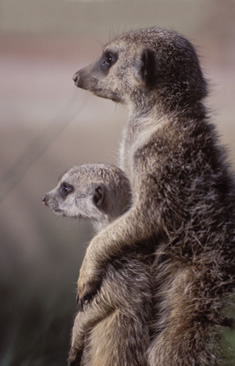Meerkat Vital Statistics
Vision: Color. The dark eye
markings act like built-in sunglasses.
Feet: Non-retractable claws.
Four toes.
Ears: Closeable.
Height: 12 inches (30 centimeters).
Weight: 2 pounds (0.9 kilograms).
Light-absorbency: Called the
"Solar Panel Of The Animal World,"
meerkats use their dark-skinned, sparsely furred
bellies to warm up.
Taxonomy: Members of the
mongoose family.
Tail: 8 inches (20 centimeters) long and used
as a tripod to balance the animal in an upright position.
Activity: Diurnal (active during
the day).
Life span: 12 to 14 years.
Society: A group of meerkats, usually five to
thirty members, is called a "mob" or a "gang."
Meerkat Home
Home range:
Southern Africa/Kalahari Desert
Dwelling: Grass-lined burrows that are shared with
ground squirrels and yellow mongooses.
Toilet: Common latrine used by
all members.
Transience: Mob moves several
times annually if food supply is depleted.
Competitiveness: Meerkats are very territorial
and will fiercely defend their home from other meerkat gangs. |
 |
|
©
Roberta Stacy |
Meerkat Predators
Guardianship: Meerkats are "snack size"
for a number of animals, so one always stands guard while
the others forage or nap.
Primary predators:
Martial eagles and jackals.
911: Various alarm calls
indicate different predators. |
Meerkat Romance
Specialization: Alpha
male and female do most of the breeding.
Litter size: 2 to 5.
Gestation: Eleven
weeks.
Breeding season: October-April in the wild.
Year-round in captivity.
Helplessness: Born with eyes and
ears closed. Sparsely furred.
Helpfulness: Various
adults will baby-sit the youngsters while
the mother feeds.
Precociousness: Sexually
mature at one year. |
Meerkat Food
Diet: Scorpions (meerkats are immune to
their venom), beetles, spiders, centipedes, millipedes,
worms, crickets (FAST food), small mammals, small reptiles,
birds, eggs, tubers and roots. |
|
Fellow Earthlings' Wildlife Center, Inc.
11427 West Drive
Morongo Valley, CA 92256
(760) 363-1344
info@FellowEarthlings.org
|
|

